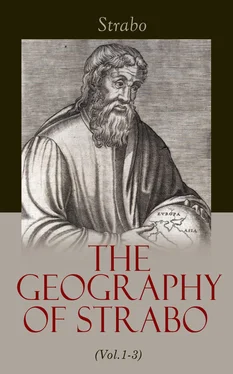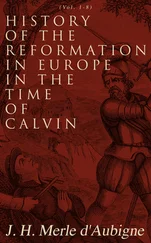Strabo - The Geography of Strabo (Vol.1-3)
Здесь есть возможность читать онлайн «Strabo - The Geography of Strabo (Vol.1-3)» — ознакомительный отрывок электронной книги совершенно бесплатно, а после прочтения отрывка купить полную версию. В некоторых случаях можно слушать аудио, скачать через торрент в формате fb2 и присутствует краткое содержание. Жанр: unrecognised, на английском языке. Описание произведения, (предисловие) а так же отзывы посетителей доступны на портале библиотеки ЛибКат.
- Название:The Geography of Strabo (Vol.1-3)
- Автор:
- Жанр:
- Год:неизвестен
- ISBN:нет данных
- Рейтинг книги:3 / 5. Голосов: 1
-
Избранное:Добавить в избранное
- Отзывы:
-
Ваша оценка:
- 60
- 1
- 2
- 3
- 4
- 5
The Geography of Strabo (Vol.1-3): краткое содержание, описание и аннотация
Предлагаем к чтению аннотацию, описание, краткое содержание или предисловие (зависит от того, что написал сам автор книги «The Geography of Strabo (Vol.1-3)»). Если вы не нашли необходимую информацию о книге — напишите в комментариях, мы постараемся отыскать её.
The Geography of Strabo (Vol.1-3) — читать онлайн ознакомительный отрывок
Ниже представлен текст книги, разбитый по страницам. Система сохранения места последней прочитанной страницы, позволяет с удобством читать онлайн бесплатно книгу «The Geography of Strabo (Vol.1-3)», без необходимости каждый раз заново искать на чём Вы остановились. Поставьте закладку, и сможете в любой момент перейти на страницу, на которой закончили чтение.
Интервал:
Закладка:
5. The whole [of Latium] is fertile, and abounding in every production, with the exception of a few districts along the coast, which are marshy and unhealthy; such as the country of Ardea, the lands between Antium and Lanuvium as far as Pometia, and certain of the districts of Setia, 1817Terracina, and Circæum. Some parts may also be too mountainous and rocky; but even these are not absolutely idle and useless, since they furnish abundant pasturage, wood, and the peculiar productions of the marsh and rock; while Cæcubum, which is entirely marshy, nourishes a vine, the dendritis, 1818which produces the most excellent wine. Of the maritime cities of Latium, one is Ostia. This city has no port, owing to the accumulation of the alluvial deposit brought down by the Tiber, which is swelled by numerous rivers; vessels therefore bring to anchor further out, but not without danger; however, gain overcomes every thing, for there is an abundance of lighters in readiness to freight and unfreight the larger ships, before they approach the mouth of the river, and thus enable them to perform their voyage speedily. Being lightened of a part of their cargo, they enter the river and sail up to Rome, a distance of about 190 stadia. Such is the city of Ostia, founded by Ancus Martius. Next in order comes Antium, which city is likewise destitute of any port; it is situated on rocks, and about 260 stadia distant from Ostia. At the present day it is devoted to the leisure and recreation of statesmen from their political duties, whenever they can find time, and is in consequence covered with sumptuous mansions suited to such rusticating. The inhabitants of Antium had formerly a marine, and even after they were under subjection to the Romans, took part with the Tyrrhenian pirates. Of this, first, Alexander sent to complain; after him Demetrius, having taken many of these pirates, sent them to the Romans, saying that he would surrender them their persons on account of their affinity to the Greeks, and remarking at the same time, that it seemed to him a great impropriety, that those who held sway over the whole of Italy should send out pirates, and that they who had consecrated in their forum a temple to the honour of the Dioscuri, 1819whom all denominated the Saviours, should likewise send to commit acts of piracy on Greece, which was the fatherland of those divinities. Hereupon the Romans put a stop to this occupation [piracy]. Between these two cities is Lavinium, which contains a temple of Venus common to all the Latini, the care of which is intrusted to the priests of [Pg 346] [CAS. 232] Ardea. After this is Laurentum; 1820and above these lies Ardea, a colony of the Rutuli, 70 stadia from the sea; near to it is another temple of Venus, where all the Latini hold a public festival. These regions have been ravaged by the Samnitæ, and only the traces of the cities left; but even these are reverenced on account of the arrival of Æneas here, and of the religious rites which they say were bequeathed from those times.
6. At 290 stadia from Antium is Mount Circæum, insulated by the sea and marshes. They say that it contains numerous roots, but this perhaps is only to harmonize with the myth relating to Circe. It has a small city, together with a temple to Circe and an altar to Minerva; they likewise say that a cup is shown which belonged to Ulysses. Between [Antium and Circæum] is the river Stura, 1821which has a station for ships: the rest of the coast is exposed to the sout-hwest wind, 1822with the exception of this small harbour of Circæum. 1823Above this, in the interior, is the Pomentine plain: the region next to this was formerly inhabited by the Ausonians, who likewise possessed Campania: next after these the Osci, who also held part of Campania; now, however, as we have remarked, the whole, as far as Sinuessa, belongs to the Latini. A peculiar fate has attended the Osci and Ausonians; for although the Osci have ceased to exist as a distinct tribe, their dialect is extant among the Romans, dramatic and burlesque pieces composed in it being still represented at certain games which were instituted in ancient times. And as for the Ausonians, although they never have dwelt by the sea of Sicily, 1824it is named the Ausonian Sea. At 100 stadia from Circæum is Tarracina, formerly named Trachina, 1825on account of its ruggedness; before it is a great marsh, formed by two rivers, the larger of which is called the Aufidus. 1826This is the first place where the Via Appia approaches the sea. This road is paved from Rome to Brundusium, 1827and has great traffic. Of the maritime cities, these alone are situated on it; Tarracina, beyond it Formiæ, 1828Minturnæ, 1829Sinuessa, 1830and towards its extremity Tarentum and Brundusium. Near to Tarracina, advancing in the direction of Rome, a canal runs by the side of the Via Appia, which is supplied at intervals by water from the marshes and rivers. Travellers generally sail up it by night, embarking in the evening, and landing in the morning to travel the rest of their journey by the way: however, during the day the passage boat is towed by mules. 1831Beyond is Formiæ, founded by the Lacedæmonians, and formerly called Hormiæ, on account of its excellent port. Between these [two cities], 1832is a gulf which they have named Caiata, 1833in fact all gulfs are called by the Lacedæmonians Caietæ: some, however, say that the gulf received this appellation from [Caieta], the nurse of Æneas. From Tarracina to the promontory of Caiata is a length of 100 stadia. Here 1834are opened vast caverns, which contain large and sumptuous mansions. From hence to Formiæ is a distance of 40 stadia. Between this city and Sinuessa, at a distance of about 80 stadia from each, is Minturnæ. The river Liris, 1835formerly named the Clanis, flows through it. It descends from the Apennines, passes through the country of the Vescini, 1836and by the village of Fregellæ, (formerly a famous city,) and so into a sacred grove situated below the city, and held in great veneration by the people of Minturnæ. There are two islands, named Pandataria and Pontia, 1837lying in the high sea, and clearly discernible from the caverns. Although small, they are well inhabited, are not at any great distance from each other, and at 250 stadia from the mainland. Cæcubum is situated on the gulf of Caiata, and next to it Fundi, a city on the Via Appia. All these places produce excellent wines; but those of Cæcubum, Fundi, and Setia 1838are most in repute, and so are the Falernian, Alban, 1839and Statanian wines. Sinuessa is situated in a gulf from which it takes its name, sinus signifying [Pg 348] [CAS. 234] [in Latin] a gulf. Near to it are some fine hot-baths, good for the cure of various maladies. Such are the maritime cities of Latium.
7. In the interior, the first city above Ostia is Rome; it is the only city built on the Tiber. It has been remarked above, that its position was fixed, not by choice, but necessity; to this must be added, that those who afterwards enlarged it, were not at liberty to select a better site, being prevented by what was already built. The first [kings] fortified the Capitol, the Palatium, and the Collis Quirinalis, which was so easy of access, that when Titus Tatius came to avenge the rape of the [Sabine] virgins, he took it on the first assault. Ancus Marcius, who added Mount Cælius and the Aventine Mount with the intermediate plain, separated as these places were both from each other and from what had been formerly fortified, was compelled to do this of necessity; since he did not consider it proper to leave outside his walls, heights so well protected by nature, to whomsoever might have a mind to fortify themselves upon them, while at the same time he was not capable of enclosing the whole as far as Mount Quirinus. Servius perceived this defect, and added the Esquiline and Viminal hills. As these were both of easy access from without, a deep trench was dug outside them and the earth thrown up on the inside, thus forming a terrace of 6 stadia in length along the inner side of the trench. This terrace he surmounted with a wall flanked with towers, and extending from the Colline 1840to the Esquiline gate. Midway along the terrace is a third gate, named after the Viminal hill. Such is the Roman rampart, which seems to stand in need of other ramparts itself. But it seems to me that the first [founders] were of opinion, both in regard to themselves and their successors, that Romans had to depend not on fortifications, but on arms and their individual valour, both for safety and for wealth, and that walls were not a defence to men, but men were a defence to walls. At the period of its commencement, when the large and fertile districts surrounding the city belonged to others, and while it lay easily open to assault, there was nothing in its position which could be looked upon as favourable; but when by valour and labour these districts became its own, there succeeded a tide of prosperity surpassing the advantages of every other place. Thus, notwithstanding the prodigious increase of the city, there has been plenty of food, and also of wood and stone for ceaseless building, rendered necessary by the falling down of houses, and on account of conflagrations, and of the sales, which seem never to cease. These sales are a kind of voluntary falling down of houses, each owner knocking down and rebuilding one part or another according to his individual taste. For these purposes the numerous quarries, the forests, and the rivers which convey the materials, offer wonderful facilities. Of these rivers, the first is the Teverone, 1841which flows from Alba, a city of the Latins near to the country of the Marsi, and from thence through the plain below this [city], till it unites with the Tiber. After this come the Nera 1842and the Timia, 1843which passing through Ombrica fall into the Tiber, and the Chiana, 1844which flows through Tyrrhenia and the territory of Clusium. 1845Augustus Cæsar endeavoured to avert from the city damages of the kind alluded to, and instituted a company of freedmen, who should be ready to lend their assistance in cases of conflagration; 1846whilst, as a preventive against the falling of houses, he decreed that all new buildings should not be carried so high as formerly, and that those erected along the public ways should not exceed seventy feet in height. 1847But these improvements must have ceased only for the facilities afforded by the quarries, the forests, and the ease of transport.
Читать дальшеИнтервал:
Закладка:
Похожие книги на «The Geography of Strabo (Vol.1-3)»
Представляем Вашему вниманию похожие книги на «The Geography of Strabo (Vol.1-3)» списком для выбора. Мы отобрали схожую по названию и смыслу литературу в надежде предоставить читателям больше вариантов отыскать новые, интересные, ещё непрочитанные произведения.
Обсуждение, отзывы о книге «The Geography of Strabo (Vol.1-3)» и просто собственные мнения читателей. Оставьте ваши комментарии, напишите, что Вы думаете о произведении, его смысле или главных героях. Укажите что конкретно понравилось, а что нет, и почему Вы так считаете.












![Anne Blunt - A Pilgrimage to Nejd, the Cradle of the Arab Race. Vol. 2 [of 2]](/books/750183/anne-blunt-a-pilgrimage-to-nejd-the-cradle-of-the-thumb.webp)